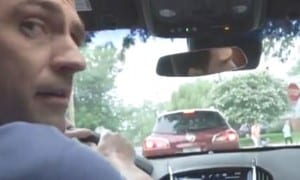 Starting with car model year 2018, the U.S. Department of Transportation’s National Highway Traffic Safety Administration (NHTSA) will update its 5-Star Rating System to include automatic emergency braking (AEB) as a recommended safety technology. The agency is also waking up to drowsy driving during National Drowsy Driving Prevention Week with a new drowsy driving program.
Starting with car model year 2018, the U.S. Department of Transportation’s National Highway Traffic Safety Administration (NHTSA) will update its 5-Star Rating System to include automatic emergency braking (AEB) as a recommended safety technology. The agency is also waking up to drowsy driving during National Drowsy Driving Prevention Week with a new drowsy driving program.
The agency reports that AEB can substantially enhance safety, especially with the number of distracted drivers on the road.
AEB systems combine inputs from forward-looking radar and/or camera sensors and driver inputs to determine if a rear-end crash is likely to happen. AEB technology includes two systems—crash imminent braking (CIB), which applies the brakes in cases where a rear-end crash is imminent and the driver isn’t taking any action to avoid the crash, and dynamic brake support (DBS), which supplements the driver’s braking input if the driver isn’t applying sufficient braking to avoid a rear-end crash.
“We’re putting the brakes on rear-end crashes,” said NHTSA Administrator Mark Rosekind. “Wherever possible, NHTSA will encourage and accelerate technological innovations that save lives.”
Previously, in September, NHSTA and Insurance Institute for Highway Safety’s asked automakers to make forward collision alert and automatic emergency braking ADAS technology standard on light vehicles. Audi, BMW, Ford , General Motors, Mazda, Mercedes-Benz, Tesla, Toyota, Volkswagen and Volvo, will make the technology standard equipment in all car, truck and SUV models they sell.
In January, Transportation Secretary Anthony Foxx announced that the National Highway Traffic Safety Administration would add two automatic emergency braking systems to the recommended advanced safety features included under its New Car Assessment Program (NCAP).
If this news is making you sleepy–NHTSA is hosted a forum during National Drowsy Driving Prevention Week (November 1 – 8, 2015) to launch a new drowsy-driving initiative.
Experts from a wide range of fields, including the sleep sciences, traffic safety, and public health, as well as from diverse organizations including advocacy groups, industry, State government, and other Federal agencies discussed research and program objectives, consider priority public policy needs, stimulate connections between diverse stakeholders, and identify core public education needs to address the risks, consequences and countermeasures related to drowsy driving.
According to the National Sleep Foundation’s 2005 Sleep in America poll, 60% of adult drivers – about 168 million people – say they have driven a vehicle while feeling drowsy in the past year, and more than one-third, (37% or 103 million people), have actually fallen asleep at the wheel! In fact, of those who have nodded off, 13% say they have done so at least once a month. Four percent – approximately eleven million drivers – admit they have had an accident or near accident because they dozed off or were too tired to drive.
Nearly one-quarter of adults (23%) say they know someone personally who has crashed due to falling asleep at the wheel. Drowsiness was involved in one in five fatal crashes.
According to AAA’s Foundation for Traffic Safety’s annual Traffic Safety Culture Index, more than a third of drivers report having fallen asleep behind the wheel at some point in their lives, and more than one in ten has fallen asleep behind the wheel in the past year.
Videos appear below: